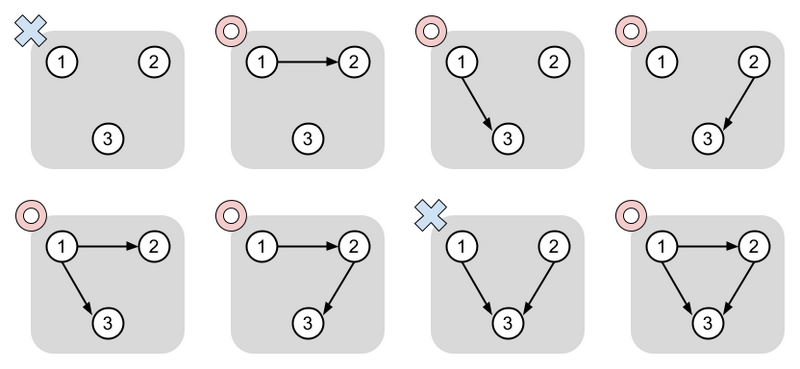Score : 1600 points
Problem Statement
There is a directed graph G with N vertices and M edges. The vertices are numbered 1 through N, and the edges are numbered 1 through M. Edge i is directed from x_i to y_i. Here, x_i < y_i holds. Also, there are no multiple edges in G.
Consider selecting a subset of the set of the M edges in G, and removing these edges from G to obtain another graph G'. There are 2^M different possible graphs as G'.
Alice and Bob play against each other in the following game played on G'. First, place two pieces on vertices 1 and 2, one on each. Then, starting from Alice, Alice and Bob alternately perform the following operation:
- Select an edge i such that there is a piece placed on vertex x_i, and move the piece to vertex y_i (if there are two pieces on vertex x_i, only move one). The two pieces are allowed to be placed on the same vertex.
The player loses when he/she becomes unable to perform the operation. We assume that both players play optimally.
Among the 2^M different possible graphs as G', how many lead to Alice's victory? Find the count modulo 10^9+7.
Constraints
- 2 ≤ N ≤ 15
- 1 ≤ M ≤ N(N-1)/2
- 1 ≤ x_i < y_i ≤ N
- All (x_i,\ y_i) are distinct.
Input
Input is given from Standard Input in the following format:
N M x_1 y_1 x_2 y_2 : x_M y_M
Output
Print the number of G' that lead to Alice's victory, modulo 10^9+7.
Sample Input 1
2 1 1 2
Sample Output 1
1
The figure below shows the two possible graphs as G'. A graph marked with ○ leads to Alice's victory, and a graph marked with × leads to Bob's victory.

Sample Input 2
3 3 1 2 1 3 2 3
Sample Output 2
6
The figure below shows the eight possible graphs as G'.

Sample Input 3
4 2 1 3 2 4
Sample Output 3
2
Sample Input 4
5 10 2 4 3 4 2 5 2 3 1 2 3 5 1 3 1 5 4 5 1 4
Sample Output 4
816